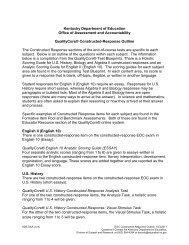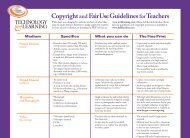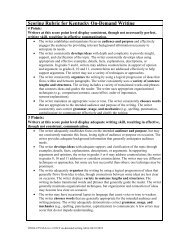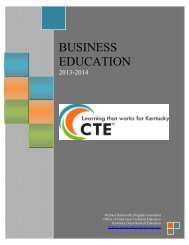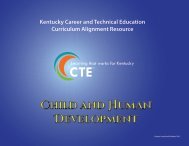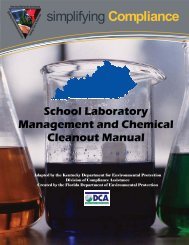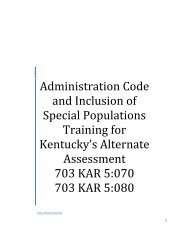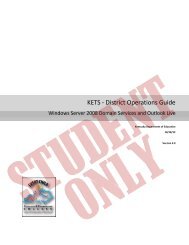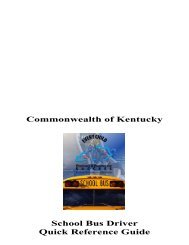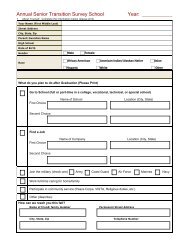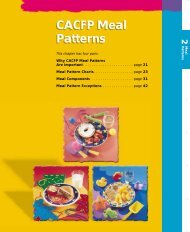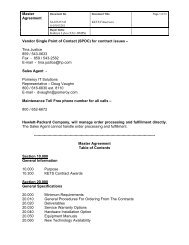Standards with Progressions grades K-HS v. 1.3 - Kentucky ...
Standards with Progressions grades K-HS v. 1.3 - Kentucky ...
Standards with Progressions grades K-HS v. 1.3 - Kentucky ...
- No tags were found...
You also want an ePaper? Increase the reach of your titles
YUMPU automatically turns print PDFs into web optimized ePapers that Google loves.
Seventh Grade Overview<br />
Domains<br />
Clusters<br />
Mathematical<br />
Practices<br />
Ratios & Proportional<br />
Relationships<br />
Analyze<br />
proportional<br />
relationships and<br />
use them to solve<br />
real-world and<br />
mathematical<br />
problems<br />
1. Make sense of problems and<br />
persevere in solving them.<br />
2. Reason abstractly and<br />
quantitatively.<br />
The Number System Expressions and Equations Geometry Statistics and Probability<br />
Apply and extend<br />
previous<br />
understandings of<br />
operations <strong>with</strong><br />
fractions to add,<br />
subtract, multiply and<br />
divide rational<br />
numbers<br />
Use properties of operations<br />
to generate equivalent<br />
expressions<br />
Solve real-life and<br />
mathematical problems using<br />
numerical and algebraic<br />
expressions and equations<br />
3. Construct viable arguments and<br />
critique the reasoning of others.<br />
4. Model <strong>with</strong> mathematics.<br />
Draw, construct and<br />
describe geometrical<br />
figures and describe the<br />
relationships between them<br />
Solve real-life and<br />
mathematical problems<br />
involving angle measure,<br />
area, surface and volume<br />
5. Use appropriate tools<br />
strategically.<br />
6. Attend to precision.<br />
Use random sampling to draw<br />
inferences about a population<br />
Draw informal comparative<br />
inferences about two populations<br />
Investigate chance processes and<br />
develop, use and evaluate<br />
probability models<br />
7. Look for and make use of<br />
structure.<br />
8. Look for and express regularity in<br />
repeated reasoning.<br />
In Grade 7, instructional time should focus on four critical areas:<br />
1. Developing understanding of and applying proportional relationships<br />
Students extend their understanding of ratios and develop understanding of proportionality to solve single- and multi-step problems. Students use their understanding of<br />
ratios and proportionality to solve a wide variety of percent problems, including those involving discounts, interest, taxes, tips, and percent increase or decrease. Students<br />
solve problems about scale drawings by relating corresponding lengths between the objects or by using the fact that relationships of lengths <strong>with</strong>in an object are preserved in<br />
similar objects. Students graph proportional relationships and understand the unit rate informally as a measure of the steepness of the related line, called the slope. They<br />
distinguish proportional relationships from other relationships.<br />
2. Developing understanding of operations <strong>with</strong> rational numbers and working <strong>with</strong> expressions and linear equations<br />
Students develop a unified understanding of number, recognizing fractions, decimals (that have a finite or a repeating decimal representation), and percents as different<br />
representations of rational numbers. Students extend addition, subtraction, multiplication, and division to all rational numbers, maintaining the properties of operations and<br />
the relationships between addition and subtraction, and multiplication and division. By applying these properties, and by viewing negative numbers in terms of everyday<br />
contexts (e.g., amounts owed or temperatures below zero), students explain and interpret the rules for adding, subtracting, multiplying, and dividing <strong>with</strong> negative numbers.<br />
They use the arithmetic of rational numbers as they formulate expressions and equations in one variable and use these equations to solve problems.<br />
3. Solving problems involving scale drawings and informal geometric constructions, and working <strong>with</strong> two- and three-dimensional shapes to solve problems involving area,<br />
surface area, and volume<br />
Students continue their work <strong>with</strong> area from Grade 6, solving problems involving the area and circumference of a circle and surface area of three-dimensional objects. In<br />
preparation for work on congruence and similarity in Grade 8 they reason about relationships among two-dimensional figures using scale drawings and informal geometric<br />
constructions, and they gain familiarity <strong>with</strong> the relationships between angles formed by intersecting lines. Students work <strong>with</strong> three-dimensional figures, relating them to<br />
two-dimensional figures by examining cross-sections. They solve real-world and mathematical problems involving area, surface area, and volume of two- and threedimensional<br />
objects composed of triangles, quadrilaterals, polygons, cubes and right prisms.<br />
4. Drawing inferences about populations based on samples<br />
Students build on their previous work <strong>with</strong> single data distributions to compare two data distributions and address questions about differences between populations. They<br />
begin informal work <strong>with</strong> random sampling to generate data sets and learn about the importance of representative samples for drawing inferences.<br />
<strong>Kentucky</strong> Department of Education<br />
45 | P a g e




